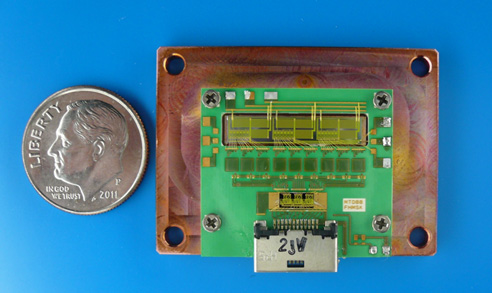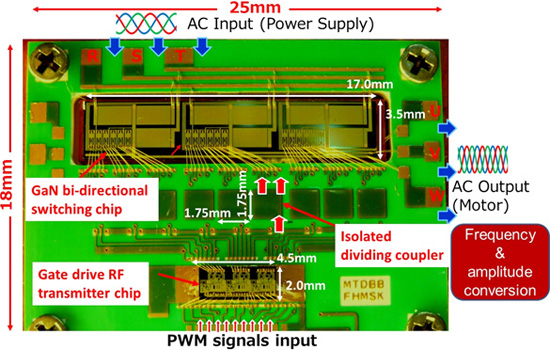
Photo of the prototype module of the new power converter
Osaka, Japan - Panasonic Corporation today announced it has developed an all-integrated power converter that allows the power switches [1] to be controlled by microwave signals. The world's first microwave-controlled power converter consists of an integrated matrix-converter [2] power switching chip that directly converts AC power to AC of the desired frequency and amplitude, and a gate drive transmitter chip that controls the power switching chip. As a result, the new converter, which is one-hundredth of the size of conventional power converters, realizes reduction of conversion power loss.
Motor-driven equipment mostly uses power conversion systems with an inverter [3] to save power. As those systems are composed of large-size discrete components, they cannot be installed in a compact system. The new ultra compact power converter consists of a GaN-based bi-directional power switching chip and a microwave gate drive transmitter chip, enabling to integrate a motor and its drive system. Further, it is maintenance-free because it does not require discrete components that can limit the life span of the system.
Conventional power converter systems using an inverter have close to 10% power conversion loss during the AC to DC conversion and the subsequent DC to AC conversion. The one-chip integration of the conventional isolated gate drivers for power switches' control has been impossible because the conventional driver uses a bulky isolated power supply [7] and a photo-coupler [8].
Panasonic will present the new power converter technology on February 12 at the IEEE international Solid-State Circuits Conference (ISSCC 2014) in San Francisco, California.
For the new GaN matrix convertor technology, Panasonic holds 144 patents in Japan and 119 patents overseas including pending applications.
<More on the Technology>
In order to efficiently rotate an AC motor with the variable speeds and torques, the power conversion with desired frequency and amplitude from AC power source is essential. Conventional power conversion systems using an inverter can realize an AC to AC power conversion by changing AC to DC first and then change DC to AC. However, there are many problems with those systems, such as large power conversion loss in the multi-step conversion, short life-time attributable to the use of large-size electrolytic capacitors, and large-size system due to an additional power factor control circuit and DC reactor.
On the other hand, since the matrix power converter that can directly convert AC to AC power consists of only power switches, it reduces its power conversion loss and simplifies its system configuration. Moreover, the further low power conversion loss is achieved because the new system employs the low-loss GaN bi-directional power switch. And the GaN bi-directional power switch that can control bi-directional switching operation with one device contributes to the drastic downsizing of the power conversion system.
The isolated coupler using wireless power transmission based on an electro-magnetic resonant coupling can be made smaller in size when it is designed at higher frequency. Then, this can be applied in semiconductor based devices by using microwaves (5GHz). Because this electro-magnetic resonant coupling conveys signal power with high efficiency over a long distance, the coupler can realize a very high DC isolation voltage such as 9.6kV. The Drive-by-microwave® technology that controls the power switch by microwave wireless power transmission is Panasonic's unique driving technology, which is the fusion of RF and power electronics.
The newly-developed isolated dividing coupler duplicates two isolated signals from an input signal by the vertically stacked 3 resonators. This reduces the gate control lines by half and leads to drastic downsizing of the system, as the system is simplified with fewer drivers. The one-chip driver constructed of GaN high-frequency devices can reduce the driving power consumption to about one-third of conventional power supply technologies because of the signal power sharing, while the conventional power supply technologies required large power consumption by 18 isolated supplies.
Because a conventional Si-based power switch has a vertical structure, the current flows from the top to the bottom in the substrate, so that the integration of multi-switches into a one chip is impossible. Since the GaN power switch has a lateral structure, the integration of the multi power switches can be realized with a simple device isolation process technology. Therefore, the extreme downsizing of the power convertor system is achieved by using the GaN 9 bi-directional power switches integration chip. A part of the microwave wireless power transmission circuit is integrated into the integration chip.
Notes:
- [1] Power switch
- This can switch an electrical line ON and OFF, where a very large current flows under very high voltage (ex.600V). Recently, the emerging GaN or SiC power switch that has a low loss gets much attention for the power saving of home electrical appliances and industrial equipment.
- [2] Matrix-convertor
- A 3 phase AC to AC matrix convertor for a 3 phase motor drive can be realized by 3 x 3 matrix configuration of nine bi-directional switches. By switching the AC lines, this can directly generate the desirable AC frequency and power from fixed AC source. On contrast to the inverter-based system, this has such advantages as high power conversion efficiency, a long life, and a regenerate operation because of the AC to AC direct conversion.
- [3] Inverter
- This is the power conversion system that can generate AC power from DC power source by twelve power devices consisting of power switches and diodes.
- [4] GaN bi-directional power switch
- This is capable of conducting currents and blocking voltage of both polarities. Although 2 power switches and 2 diodes are needed to realize this function with the conventional Si power device, the GaN bi-directional switch performs this operation with only one device.
- [5] Isolated gate driver
- This provides electrical isolation as well as strong gate drive to control a power switch ON and OFF, which is often required for safety and robustness in many system architectures.
- [6] Wireless power transmission
- This is the transmission of electrical energy from a power source to an electrical load without physical conductors.
- [7] Isolated power supply
- This generally includes either transformers or optical isolators in both the power and the feedback paths. As a result, isolated power supplies are generally more complex in their design than no isolated power supplies.
- [8] Photo-coupler
- This can transfer electrical signals between two isolated circuits by using light. This device prevents high voltages from affecting the system receiving the signal.

Prototype module of the new power converter
(3X3 GaN matrix converter with Drive-by-microwave®)
About Panasonic
Panasonic Corporation is a worldwide leader in the development and engineering of electronic technologies and solutions for customers in residential, non-residential, mobility and personal applications. Since its founding in 1918, the company has expanded globally and now operates over 500 consolidated companies worldwide, recording consolidated net sales of 7.30 trillion yen for the year ended March 31, 2013. Committed to pursuing new value through innovation across divisional lines, the company strives to create a better life and a better world for its customers. For more information about Panasonic, please visit the company's website at http://panasonic.net/.
Drive-by-microwave® is a trademark of Panasonic Corporation.
Media Contacts:
- Tokyo Public Relations Office
Panasonic Corporation - Tel:+81-(0)3-3574-5664 Fax:+81-(0)3-3574-5699
- Panasonic News Bureau
- Tel:+81-(0)3-3542-6205 Fax:+81-(0)3-3542-9018






